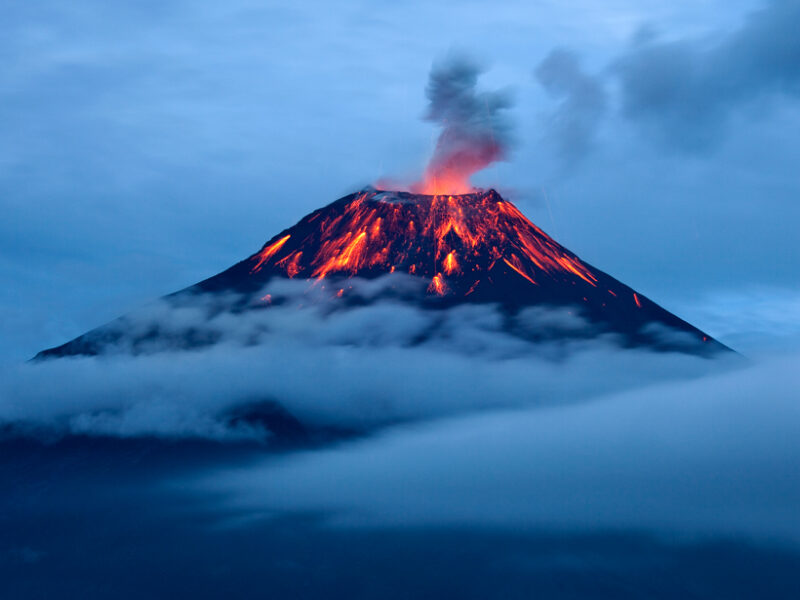
On average, more than 60 volcanoes erupt every year. Although volcanic eruptions can be amazing natural phenomena, they can also have devastating effects on the landscape, atmosphere, and living beings, and these effects can extend over great distances. Data from many types of instruments, combined with a basic understanding of how volcanoes work, can provide an important means of safeguarding lives and property by detecting the signs of an impending eruption and forecasting its size and duration.
The report summarizes opportunities to better understand volcanic eruptions and make more useful forecasts of volcano behavior.In 2016, NASA, the National Science Foundation, the U.S. Geological Survey, and the National Academies of Sciences, Engineering, and Medicine commissioned a committee to summarize our understanding of how volcanoes work. The committee’s tasks included reporting on new research and observations that will improve scientists’ ability to forecast eruptions and inform monitoring and early warning. Their consensus report, titled “Volcanic Eruptions and Their Repose, Unrest, Precursors, and Timing” (ERUPT), was released in 2017. The report summarizes opportunities to better understand volcanic eruptions and make more useful forecasts of volcano behavior.
These opportunities are possible because new measurements can better reveal where magma is stored and how it moves. New mathematical models are being developed for the processes that govern eruptions. And technological advances have enabled expanded monitoring from space and on the ground to fill important data gaps. Together, these improvements will lead to more useful forecasts of the timing, size, and consequences of eruptions.
Questions and PrioritiesThe report identifies outstanding questions and research priorities for several aspects of volcanoes.The report identifies outstanding questions and research priorities for several aspects of volcanoes: how magma is stored, rises through the crust, and then erupts; new opportunities to improve forecasting; and the interaction between volcanoes and other Earth systems. It also discusses ways to strengthen volcano science.
Three grand challenges summarize key questions, research priorities, and new approaches highlighted throughout the report:
forecast the size, duration, and hazard of eruptions by integrating observations with quantitative models of magma dynamics quantify the life cycles of volcanoes globally and overcome the biases inherent in assuming a few well-studied volcanoes represent the many develop a coordinated volcano science community to maximize scientific returns from any volcanic eventThe report notes that developing models of volcanic systems that can inform forecasting requires the integration of data and methodologies from multiple disciplines. These disciplines include remote sensing, geophysics, geochemistry, geology, atmospheric science, mathematical modeling, and statistics.
The report also identifies opportunities to move from forecasting dominated by pattern recognition to forecasting based on physics- and chemistry-based models that assimilate monitoring data. This would be a profound paradigm shift but could yield great rewards for forecasting.
Monitoring Change: Conclusions from ERUPTAt the report’s core is a simple theme: Determining the life cycle of volcanoes matters.At the report’s core is a simple theme: Determining the life cycle of volcanoes matters.
This life cycle is key to interpreting precursors and unrest; revealing the processes that govern the initiation, magnitude, and longevity of eruptions; and understanding how magmatic systems evolve during the quiescence between eruptions. Our current understanding is biased by the modest number of comprehensively monitored volcanoes, the types of eruptions that have been studied, and the small (but growing) number of volcanoes with well-established histories of their full life cycles. Satellites and expanded ground-based monitoring networks can fill some of the data gaps, as can extension of observations to the oceans.
Authors of the report agree that on the ground, a useful goal is to have at least one seismometer per volcano, complemented by more extensive ground-based monitoring at a smaller number of high-priority volcanoes. From space, achieving daily measurements of deformation and passive degassing at all volcanoes on land would ensure global and continuous coverage. Ideally, degassing measurements would monitor carbon dioxide emissions, as well as sulfur dioxide.
High-resolution maps of thermal emissions and topography and the way they change over time are useful for understanding a spectrum of volcanic processes and Earth system responses to eruptions, the report notes. It also stresses that geological studies, augmented by mapping, scientific drilling, and geophysical imaging of volcanic systems, are necessary to understand volcanism over longer periods of time.
Myriad OpportunitiesThe volcano science community must be prepared to quickly monitor or respond to any eruption, the report notes.Capitalizing on the new expanded capabilities in volcano monitoring requires that the volcano science community be prepared to quickly monitor or respond to any eruption, the report notes. Such preparations involve strengthening multidisciplinary research, domestic and international partnerships, and training networks. Emerging technologies, including inexpensive sensors, drones, and new microanalytical geochemical methods, provide previously unimagined opportunities.
Volcano science often advances substantially following well-studied eruptions. A combination of enhanced monitoring, advancing experimental and mathematical models, and integration of research and monitoring will help the volcano science community understand and forecast volcanic eruptions and maximize what we can learn when volcanoes do erupt.
Copies of the ERUPT report are available without charge from the National Academies.
Author InformationMichael Manga (email: manga@seismo.berkeley.edu), Department of Earth and Planetary Science, University of California, Berkeley
from Eos https://eos.org/project-updates/working-together-toward-better-volcanic-forecasting?utm_source=rss&utm_medium=rss&utm_content=working-together-toward-better-volcanic-forecasting
via IFTTT
